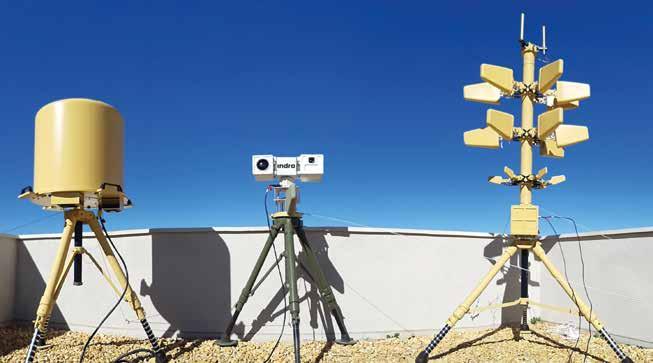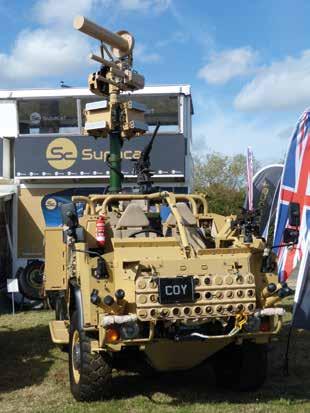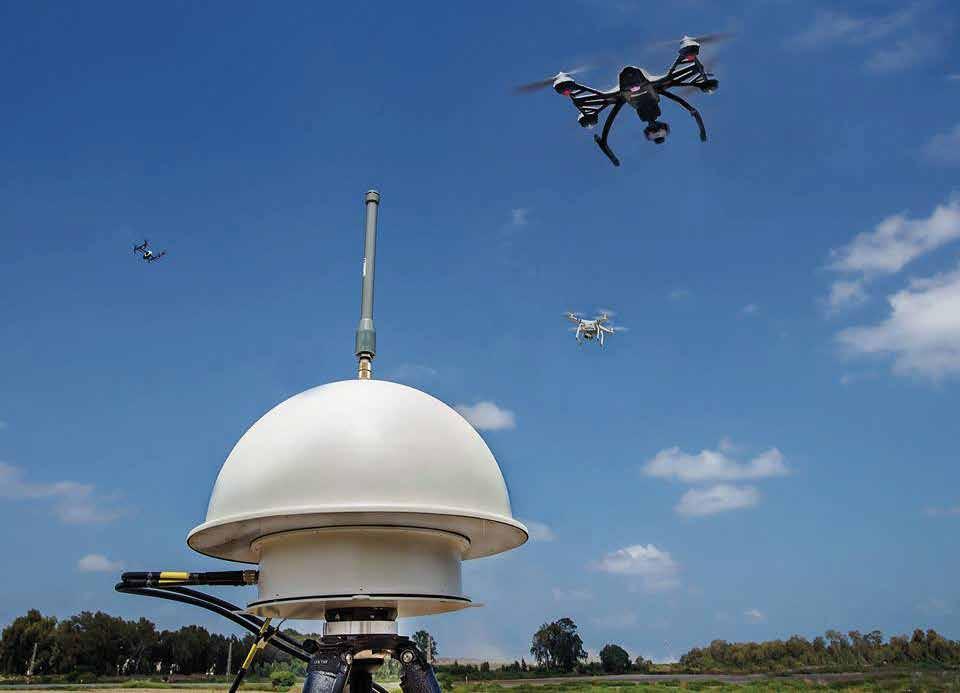
11 minute read
The Downing of
A French soldier aiming a DroneGun at a vehicle-mounted UAV during the 2019 Bastille Day military parade in Paris. © DroneShield
The Downing of the Drones
Advertisement
By David Oliver
The proliferation of unmanned aerial vehicles (UAV) has been stunningly swift prompting governments and industry to urgently seek to develop effective defence systems against these unmanned threats.
UAVs, also called remotely piloted aircraft systems (RPAS) - or drones as they are more commonly known have been introduced in increasing numbers across many nations and mainly military services. They come in various guises ranging from 4 kg quadcopters to airliner-size high-altitude long-endurance (HALE) platforms, many of which are designed or can be adapted to carry weapons.
Counter-UAV systems are equally diverse as they range from hand-held devices to anti-aircraft missile systems, segmented into laser, electronic and kinetic systems. There are at least 250 counterUAV products either on the market or under active development in 36 countries. A leading point and shoot device manufacturer is the Australia-based DroneShield Ltd. Its DroneGun MkIII is a compact, lightweight countermeasure against a wide range of small UAV designed for one hand operation. It allows for a controlled management of UAV payload such as explosives, with no damage to common
UAV models or surrounding environment due to the UAV generally responding via a vertical controlled landing on the spot, or returning back to its starting point which assists in tracking the operator. Radiofrequency (RF) disruption activation will also interfere with any live video streaming (FPV, First-Person View) back to the remote controller halting the collection of video footage and intelligence by the UAV operator.
DroneGun has the option to disrupt multiple RF frequency bands simultaneously including 433MHz, 915MHz, 2.4GHz and 5.8GHz and it also has an optional global navigation satellite systems (GNSS) disruption capability, including GLONASS and GPS.
The system allows for an up to 2 km coverage in a wide range of environmental conditions. The battery powered highly portable single rifle style is e asy to use requiring minimal technical training for set up or use.
One of its customers is France. During the Bastille Day celebrations in Paris on 14 July 2019, French troops armed with DroneGun Tactical were part of the security element deployed to protect those taking part in the military parade on the Champs-Elysées as well as the crowds watching the celebrations.
In April 2020 DroneShield released a new version of its wearable RfPatrol UAV detection device, which is smaller, lighter, and more advanced than its predecessor. Its passive receiver is designed to detect communications between the UAV and its operators, including the command signals, telemetry, location data, and video links that the UAV transmits in return. The RfPatrol MkII has “glimpse” and “stealth” modes, the latter could be particularly useful for special-forces users when they wish to hide their location.
The Russian defence industry has strongly indicated its firm intention to enter the cuttingedge branch portable C-UAV development following operations in Syria. During Russia’s major ”Vostok 2018” exercise a new hand-held C-UAV weapon was used by Russian Federation airborne troops. The REX-1 is a rifle-like, manportable jammer developed by Kalashnikov Group subsidiary ZALA Aero Group that relies on the jammer’s ability to cut the UAV off from its operator, communications bearer and autonomous navigation capability to neutralise the threat.
A Russian soldier using the REX-1 C-UAS system developed by the ZALA Aero Group during exercise ‘Vostock 2018’. © Russian MoD

Indra’s ARMS system has been developed to neutralise UAV threats using a different combination of modern technologies. © Indra

Specifications data indicate that it operates in the 2.4 GHz and 5.8 GHz ranges, which are commonly associated with wireless and mobile telephone operations, as well as GNSS such as BeiDou, Galileo, GLONASS and GPS. Suppression of GNSS signals can be made up to a 2 km radius around the system, with other communications blocked over a 30° front arc out to 500 metres.
Battery and power figures claim three hours of continuous life and 36 months on standby before needing a recharge. At a reported 4.5 kg in weight, with rifle-like dimensions and a stock based on the MP-514K air rifle, it is simple to use, offering mobile and light forces a new ability to counter proliferating UAVs, which can be hard to engage with more conventional firearms.
Several European defence contractors are offering C-UAV solutions including Indra’s whose ARMS system has been developed to neutralise UAV threats using a different combination of modern technologies. They include radar detection, RF analysis, Radio Direction finding, electro-optical detection, analysis and classification, RF datalink jamming, GNSS jamming or GNSS spoofing which are integrated in a single operation post through C4ARMS, the Command and Control unit. The basic system performs first and anticipated detection with high-resolution radars, capable of detecting small UAVs over long distances. It includes an optronic system that allows the ARMS to discriminate if detection is a tangible threat and determine its precise spatial location. Once the threat is confirmed and located, the model will then make use of

Rheimetall’s new Skymaster Mobile C-UAV concept study combines reconnaissance and surveillance capabilities with tactical effectiveness, survivability and mobility all in one platform. © Rheinmetall
a jamming system to disrupt the UAV’s guide. the air situation and command networks of loIn order to guarantee the protection of larger cal air traffic control authorities. Integration into surfaces, several ARMS can be programmed to higher-echelon unmanned traffic management work jointly. The countermeasures that are used systems is possible as well. in this environment must be especially precise so as not to affect security or interrupt the service. In The module can be installed in various vehicles, the military environment, the same applies to its enabling the crew to operate in a protected integrated use with air defense systems. environment. Dismounted operation is also possible. Furthermore, plans exist for outfitting an Rheinmetall has long since turned its attention unmanned ground vehicle with the system. to the threat posed by low, slow and small aerial threats. Having developed the Oerlikon Radshield Thales has been developing a C-UAV concept UAV detection system, its new Skymaster Mobile designed to counter hostile or unauthorised C-UAV concept study combines state-of-the-art UAVs penetrating airspace over borders, airports, reconnaissance and surveillance capabilities with and key infrastructure sites. tactical effectiveness, survivability and mobility all in one platform. The concept is focused in particular on the threat posed by Class 1 UAVs weighing less than 25 kg, The Skymaster Mobile concept is intended for use including some micro and mini-UAVs that can in tightly controlled airspace. The system enables weigh less than 2 kg and have a radar cross-section detection, classification and where necessary of less than 0.01 m 2 that tend to fly slow, low, and interception and capture of extremely small aerial among ground clutter which can be a challenge vehicles. to detect. The Thales solution could be integrated into a wider Ground Based Air Defence system as The roof module features an advanced 3D AESA well as potential to be integrated with more kinetic search radar with 360° coverage and an eleceffectors to disrupt targeted UAVs including the tro-optical verifier. This lets the operator identify company’s own Lightweight Multirole Missile objects detected by the radar from the safety of (LLM) and RapidFire 40 mm gun system using the protected interior of the vehicle. If required, additional detection sensors such as a passive emitter locator (PEL) The CPM Elettronica Owl-48 is a multiband DJI-120-48 C-UAS jammer system and a light detection and adapted to be installed on top of FLIR’s ranging (LIDAR) system can HRC camera system. © CPM Elettronica also be integrated, as can other sensors and datalinks. If a target poses a threat, a number of effectors are at the operator’s disposal. These include various catch-and-carry interceptor UAVs as well as directional jammers. By means of data fusion and automatic generation of a local air situation picture the integrated Skymaster command system aids the operator. It also exchanges information with

The Anti-UAV Defence Systems (AUDS) mounted on a Supacat Coyote has been developed by a UK defence consortium. © David Oliver

air bursting munition. Thales is also working on a directed energy solution to disrupt UAVs. Thales has participated in a national French project for the development of a counter UAV programme known as Angelas. The Office National d’Etudes et de Recherches Aérospatiales (ONERA), the French national aerospace research centre has established and led the research, which included several companies and organisations.
Another French company, CerbAir was created to counter the alarming increase of UAV intrusions on national territory, as well as the threat they represent. At the heart of its C-UAV solutions is its Hydra RF technology that is passive, causing no interference to surrounding networks. It works by detecting the communication between a drone and its remote control. Depending on your needs, secondary technologies, such as EO/IR, radar, etc. may be added.
CerbAir’s proprietary algorithms locate the UAV and its pilot and can identify an intruding UAV’s make and model in real time. Its specially designed Medusa Electronic Countermeasure instantly triggers the UAV’s emergency procedure, stopping it in its tracks. The system’s sensors can be installed on buildings, in vehicles or housed in a backpack.
CerbAir has been working with the Administrator of the French Armed Forces and coordinator of France’s participation in NATO, and the Colombian Air Force (FAC), one of the three institutions of the country’s Military Forces charged working to exercise and maintain control of Colombia’s airspace and to defend its territorial integrity.
The Italian-based CPM Elettronica with its Drone Jammer range of solutions offers different configured equipment against all type of RF/GPS controlled UAVs. The CPM-WATSON and CPMWILSON are light handheld multi band C-UAV jammers capable of cutting off the most common links between the UAV and the operator’s GSSN, and the new generation of possible frequencies.
The CPM Owl-48 is a multi band DJI-120- 48 C-UAS jammer, specifically adapted to be installed on top of FLIR’s HRC camera system with the objective of creating and maintain an effective no-fly zone for remotely-controlled UAVs. It has been delivered to the Italian Army and Air Force and the French Gendarerie.
The Anti-UAV Defence Systems (AUDS) has been developed by a UK defence consortium comprised of Blighter Surveillance Systems, Chess Dynamics, and Enterprise Control Systems (ECS). Primarily designed to counter small UAVs, the system features Blighter’s A400 Series Ku-band electronic scanning air security radar to detect the UAV, Chess Dynamics’ Hawkeye stabilised electro-optic director, infrared and daylight cameras, and target tracking software, and a directional RF inhibitor from ECS, which provides the disrupt element by selectively interfering with the command-and-control channels on the air vehicle.
According to manufacturers, the AUDS has now reached Technology Readiness Level 9 and undergone extensive evaluation with military and government organisations, taking part in 12
Elbit System’s ReDrone anti-UAV protection system is capable of detecting and neutralising several UAVs simultaneously. © Elbit Systems

overseas trials. Available data claim that the system is able to detect a target at a distance of 10 km and enact the full process of detect, track, and defeat in around 8-15 seconds enabling the operator to take control of the UAV and force it to land.
A range of configurations for the AUDS system have been developed, enabling it to be deployed as a fixed, semi-permanent, a temporary asset or a vehicle.
Having been at the forefront of military UAV development, Israel is now offering systems for defending against them. Rafael’s proven Drone Dome C-UAV solution for securing air space from hostile UAVs is fully operational and deployed globally. Drone Dome comprises of electronic jammers and sensors, allowing effective detection, full identification and neutralization of multiple micro and mini UAV threats by employing its unique algorithms. One of its unique capabilities is integrating laser technology for hard-kill. When the C 4 I performs a positive identification, the system allocates the target to the laser effector, which locks and tracks the target and performs hardkill. In recent demonstrations conducted in Israel, the Drone Dome system performed interceptions of multiple UAVs, using its hard-kill laser beam director. The system achieved 100 percent success in all test scenarios.
Elbit System’s ReDrone is an anti-UAV protection system designed to detect, identify, track and neutralise different types of UAVs at a designated airspace. The system is capable of pinpointing both the air vehicle and its operator’s directions while its advanced detection system provides 360-degree perimeter protection and real-time situational awareness. It can also deal with several UAVs simultaneously. After detecting a target, the ReDrone system disrupts the UAV’s communication with its operator, blocks its radio and video signals and GPS positioning data, and sends it off track, preventing it from carrying out an attack.
As UAVs become more sophisticated and their acquisition and deployment proliferates, so C-UAV systems manufacturers will attempt to stay one step ahead in the detection and neutralisation of the threats they pose.





